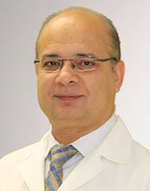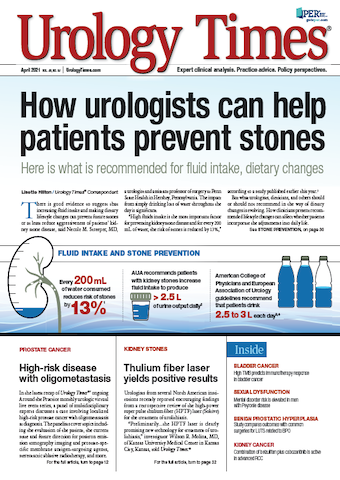Publication
Article
Urology Times Journal
Prostate cancer functional and oncological outcomes vary among surgeons
Author(s):
The trend persists even after adjusting for surgical volume and experience.
Badar M. Mian, MD

For men undergoing surgery for localized prostate cancer, which is often diagnosed at an early, curable stage, functional outcomes as important as oncological outcomes. Patient and tumor characteristics are often the subject of post-surgical outcomes studies. But, despite the commonly held belief that surgeon-related factors are an important determinant of surgical outcomes, the studies evaluating the effect of surgeon-related factors are infrequent and opaque.
In a recent update of a previously reported trial,1,2 Nyberg et al examine the effect of heterogeneity in surgeon experience and caseload on the outcomes after radical prostatectomy.1 A previous report on the Laparoscopic Prostatectomy Robot Open (LAPPRO) trial (a prospective, non-randomized, multicenter trial) comparing open radical prostatectomy (ORP) and robot-assisted laparoscopic prostatectomy (RALP) procedures demonstrated that there was no difference in the rate of urinary incontinence or oncological outcomes, and modestly improved erectile function after RALP.
The trial was conducted at 14 Swedish centers by 68 surgeons; however, the previous report only included surgeons who had performed at least 100 RPs before participating in the trial. In the current report, the authors included all participating surgeons to determine the influence of surgeon-related factors (including previous experience and current caseload) on the outcomes and to determine whether surgeon heterogeneity affected the comparative outcomes of ORP and RALP. The outcome measures included urinary incontinence, erectile dysfunction (ED), and cancer recurrence (prostate-specific antigen > 0.25 ng/mL) at 24 months after surgery.
Of the 3443 evaluable patients for this analysis, 826 underwent ORP and 2617 underwent RALP. A model including surgeons with at least 20 procedures during the study was developed that adjusted for the baseline patient and tumor characteristics to account for any differences in the case mix. Additional analyses included the subgroup of experienced surgeons (> 250 cases) and the annual caseload of surgeons during the study.
Amongst the main cohort of surgeons with 20 or more cases during the study period (n = 25), significant heterogeneity was noted in the incontinence rates, ranging from 5% to 30% (P =.001). The rate of ED also varied significantly, ranging from 61% to 93% (P <.001). Similarly, wide variation was noted in the recurrence rate from 4% to 35% (P <.001). In the subgroup of surgeons with prior experience with more than 250 RPs (n = 12), significant heterogeneity in outcomes during the trial was noted in the rate of incontinence (P = .008), rate of ED (P < .001) and recurrence rate (P = .03). Despite adjusting for annual caseload, statistically significant heterogeneity of outcomes persisted for incontinence rate (P =.009) and rate of ED (P <.001), but not for recurrence rate (P =.8).
The authors analyzed the effect of prior experience, annual caseload, and extent of nerve sparing to determine the role of these surgeon-related factors on the heterogeneity in outcomes noted amongst the surgeons. It was noted that surgeons’ prior experience accounted for 42% of observed heterogeneity regarding incontinence (P =.003) and 11% regarding ED (P =.03), but did not affect the recurrence rate. The caseload during the trial accounted for 19% of heterogeneity in the rate of recurrence (P =.01), but it did not significantly influence the rate of incontinence or ED. The extent of nerve-sparing explained only 5% of heterogeneity in both incontinence and ED (P =.002 and P ≤ .001, respectively).
The authors also evaluated whether the baseline patient/tumor characteristics and surgeon-related factors could explain the difference in the outcomes of ORP and RALP. After adjusting for baseline patient and tumor characteristics only, the difference in incontinence rate was significantly lower after ORP than after RALP.
Adjusting for the annual caseload increased the difference in favor of ORP whereas adjustments for previous experience reduced the difference in incontinence rate. Regarding ED, there was no statistically significant difference between ORP and RALP at baseline, but adjusting for surgeons’ experience alone, or in combination with current caseload resulted in improvement (less ED) in favor of RALP. In terms of recurrence rates, there was no significant difference between ORP and RALP at baseline, and additional adjustments for surgeons’ caseload or experience did not change this outcome.
Data raise several questions
This report demonstrates a large and significant variability of functional and oncological outcomes amongst individual surgeons, without clearly demonstrating the superiority of either ORP and RALP. The most important factor affecting the heterogeneity of functional outcomes appears to be the surgeon’s prior experience, whereas current caseload had a significant impact on oncological outcomes. This raises other questions that are of importance to the surgical specialties, our patients, and the health care systems in general. How do we identify surgeons with clearly better outcomes and train the ones in need of improvement? Who should have the responsibility or authority (the department or the hospital) to collect such data? If the surgeons’ outcomes data are to be placed in the public domain, what necessary steps would be required to ensure that the data are robust and the public is sufficiently educated to use that information properly?
It is important to note that the variability in functional and oncologic outcomes in this study persisted even after adjusting for surgical volume and experience. This clearly suggests that surgical volume alone is insufficient to promise improved outcomes after RP. There must be some other unmeasured or intangible factors that influence the functional and oncologic outcomes such as advanced training, hand-eye coordination, and tissue handling.
In a patient-centric approach, monitoring and reporting surgical outcomes, albeit challenging, may become necessary. Further efforts such as anonymous review of surgical videos, and intervention such as additional training, peer review, and feedback may be warranted to reduce the significant heterogeneity in outcomes noted amongst surgeons.
Mian is professor of surgery in the division of urology at Albany Medical College, Albany, New York.
References
1. Nyberg M, Hugosson J, Wiklund P, et al. Functional and oncologic outcomes between open and robotic radical prostatectomy at 24-month follow-up in the Swedish LAPPRO trial. Eur Urol Oncol. 2018;1(5)353-360. doi:10.1016/j.euo.2018.04.012
2. Nyberg M, Sjoberg DD, Carlsson SV, et al. Surgeon heterogeneity significantly affects functional and oncological outcomes after radical prostatectomy in the Swedish LAPPRO trial. BJU Int. 2021;127(3):361-368. doi:10.1111/bju.15238

Newsletter
Stay current with the latest urology news and practice-changing insights — sign up now for the essential updates every urologist needs.





























